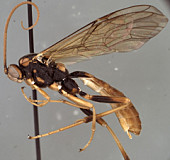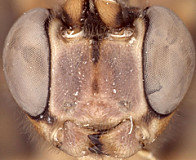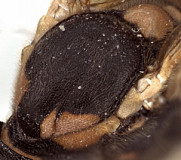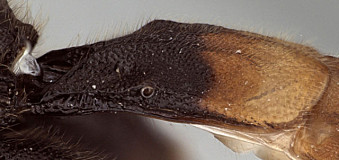Clypeus (Fig. 2) tall, narrow, usually bulging with rounded transverse ridge dorsally, flattened to weakly impressed ventrally, rarely completely falttened; ventral margin sharp throughout, truncate to narrowly concave medially, with lateral margins distinctly angled dorsally; epistomal sulcus usually shallow, not sharp. Malar space about 0.4-0.6 times basal width of mandible. Mandible (Fig. 2) short, strongly curved, very broad basally, somewhat abruptly narrowing from base to middle, then more nearly parallel-sided over apical half; dorsal tooth varying from about equal in length to ventral tooth to slightly longer, dorsal tooth usually broader than ventral tooth; ventral margin carinate, usually strongly so. Inner eye margins parallel. Female ocelli often small, with maximum diameter of lateral ocellus distinctly shorter than distance between ocellus and eye, ocellus slightly larger in some specimens examined, with diameter more nearly equal to distance from ocellus to eye. Antennae often a little shorter than body; relative lengths of first two flagellomeres as in Fig. 1. Hypostomal carina joining occipital carina well above base of mandible; occipital carina complete. Epomia usually (80%) absent. Dorsal end of epicnemial carina weak, not extending to anterior margin of mesopleuron; mesopleuron punctate, usually coarsely so, occasionally with punctures confluent to form weakly rugulose sculpture, otherwise polished, not mat. Notaulus usually exceptionally well developed (Fig. 3), deeply and narrowly impressed on anterior declivity, the deep incision extending anteriorly to margin and posteriorly usually to level of anterior margin of tegula, either absent posteriorad tegula or weaker, the two sides converging to a shallow median depression. Deep, broad, U-shaped groove visible in lateral view between anterior end of lateral longitudinal carina and thorn-like extension of posterior margin of metathorax. Pleural carina usually distinct dorsoanteriorly, weak to absent ventroposteriorly; propodeal carinae rarely weakly developed and nearly absent; usually (Fig. 4) in form of rounded ridges: lateral longitudinal carina usually complete, median longitudinal carinae narrowly separated medially; posterior transverse carina often complete, with petiolar area roughly delimited; propodeum coarsely sculptured. Legs with apical comb on posterior side of hind tibia short but often well developed, moderately dense; hind tibial spurs long, slender (Fig. 1), longest spur nearly as long as half length of long hind leg basitarsus; all tarsal claws simple, not pectinate. Fore wing (Figs 1, 5) with areolet present; stigma very narrow, not discrete distally, Rs+2r arising from basal 0.3-0.4; remnant of RS+M (the ramulus of
Townes 1970) often present and sometimes long as in Fig. 5. Hind wing with first abscissa of CU1 usually much longer than 1cu-a, sometimes nearly equal in length. T1 (Fig. 6) not long and narrow, gradually widening posteriorly; dorsal carinae represented by tall ridges basally delineating margins of deep basal depression of dorsal tendon attachment, more rounded posteriorly, nearly always extending to level of spiracle, sometimes extending nearly to apical margin as low, rounded elevations; dorsal-lateral carina sharp and distinct from spiracle to posterior margin of T1; glymma deep, broad basally, narrowing posteriorly. S1 not extending to level of spiracle, about 0.3-0.4 times length of T1. T2 thyridium present; laterotergites of T2 and T3 completely separated by creases. Ovipositor short, more or less straight, with deep, broad subapical, dorsal notch; ovipositor sheath (Fig. 1) about as long as posterior hind tibial spur. Apex of female metasoma as in Fig. 1.
The species of Protarchus are large and relatively stout.
This description is modified from Townes (1970) and based largely on about five Palaearctic species in the Texas A&M University Collection.







